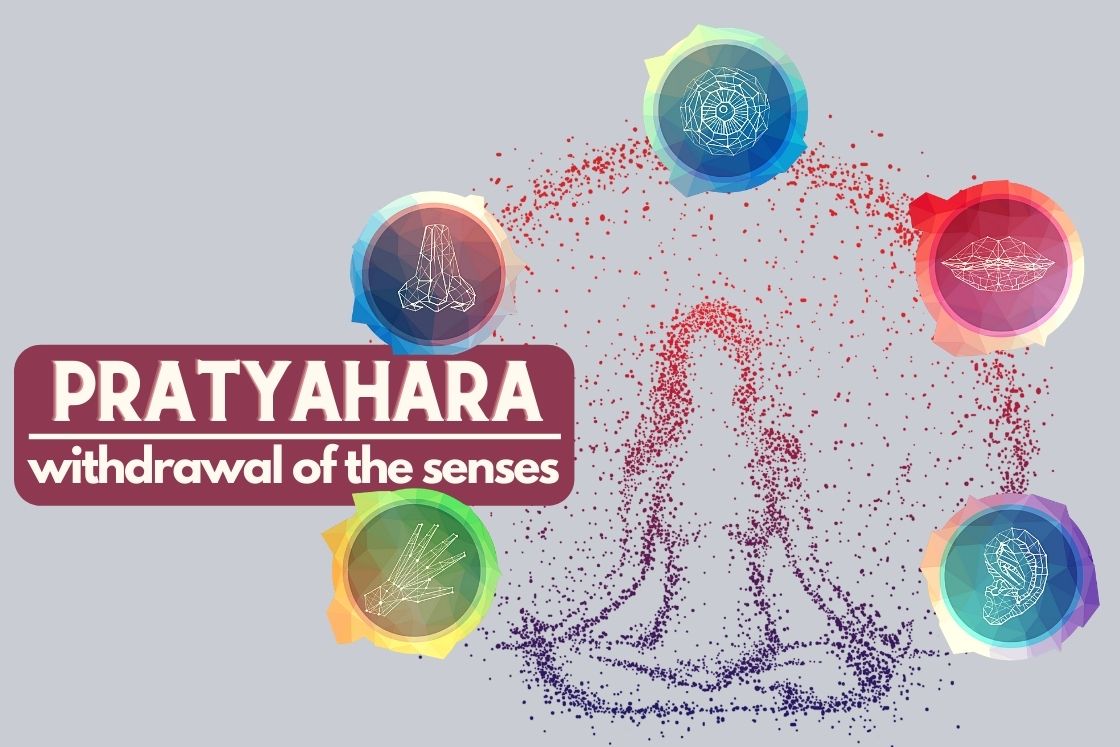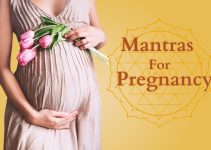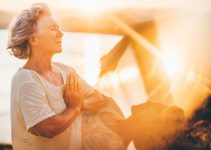
Pratyahara is the fifth limb of the eightfold path of yoga (Ashtanga Yoga) described by Patanjali. It means “withdrawal of the senses” and marks the turning point from external practices like posture and breath control to internal practices like concentration and meditation.
In simple terms, Pratyahara is the practice of turning your senses inward, away from external distractions, to prepare the mind for deep meditation.
In yoga philosophy, there are 11 sense organs involved in this process:
- Five organs of perception (Pancha Jnanendriyas): eyes, ears, nose, tongue, and skin
- Five organs of action (Pancha Karmendriyas): hands, feet, speech, excretory organs, and reproductive organs
- One internal sense: the mind (manas), which coordinates and interprets sensory input
Among these, the mind is the most powerful. When the mind and senses are withdrawn from external objects, it becomes easier to enter meditation and experience inner stillness
Traditional definition of pratyahara
In the Yoga Sutras of Patanjali, Pratyahara is introduced in Chapter 2: Sadhana Pada, after the first four limbs Yama, Niyama, Asana, and Pranayama.
svaviṣaya-asaṁprayoge cittasya svarūpānukāra iva indriyāṇāṁ pratyāhāraḥ
(Yoga Sutras 2.54)
This sutra can be interpreted as:
“Pratyahara is the withdrawal of the senses from their objects, just as the mind withdraws from external impressions and reflects its own true nature.”
Here, Maharishi Patanjali defines Pratyahara as a state where the senses no longer follow their usual outward path toward sensory objects. Instead, they turn inward, allowing the consciousness (Chitta) to rest in its own nature. This inner withdrawal sets the stage for true meditation (Dhyana).
Meaning
The word Pratyahara is a Sanskrit term composed of two parts:
- Prati – meaning against or away from
- Ahara – meaning food or intake
In yogic context, Ahara refers not only to physical food, but also to everything we take in through our sense organs sights, sounds, smells, tastes, and touch. Thus, Pratyahara literally means “withdrawal from what is taken in”, or more clearly, “withdrawal of the senses from external objects.”
In our daily lives, the senses (called Jnanendriyas in yoga) are constantly engaged with the outer world:
- Eyes, ears, nose, tongue, and skin help us perceive external objects
- Organs of action (Karmendriyas) like the hands, feet, mouth, genitals, and anus help us respond
This constant interaction keeps our awareness externalized.
But in the practice of Pratyahara, we begin to reverse this flow. Instead of reacting to the outer world, we gently redirect the senses inward. The mind becomes calm and starts observing what’s happening within thoughts, emotions, breath, and inner energy. This shift is essential for entering deeper states of meditation.
Pratyahara in real world
In the outer world, we are constantly stimulated by sights, sounds, and experiences. But the inner world is naturally calmer and more peaceful. That’s why in yoga, we learn to turn our awareness inward this is the essence of Pratyahara.

The Turtle Analogy
A powerful symbol of Pratyahara is the turtle. Just as a turtle withdraws its limbs when it senses danger, we too must learn to withdraw our senses when overwhelmed by stress, anxiety, or distractions.
In this case, our “limbs” are the five sense organs that keep us connected to the external world. Pratyahara teaches us to gently pull these senses back, allowing the mind to rest in stillness.
Real-World Examples of Pratyahara
Here are simple moments when you may have already practised Pratyahara without knowing it:
- You smell your favourite food while working, but you stay focused instead of getting distracted.
- Someone says something unpleasant, but instead of reacting emotionally, you stay calm and respond wisely.
- You stub your toe while walking, but instead of reacting with anger or pain, you simply observe the sensation and let it pass.
In all these situations, you were not ruled by your senses you chose to stay in control. This is Pratyahara in action.
Before pratyahara begins

In the eight limbs of yoga described by Patanjali, the path begins with Yama, Niyama, Asana, and Pranayama. These are known as Bahiranga Yoga, or the external limbs, because they involve discipline, posture, and breath practices rooted in the outer world.
The last four limbs Pratyahara, Dharana, Dhyana, and Samadhi are called Ashtanga Yoga, the internal limbs. These guide the practitioner inward, toward mental clarity and spiritual stillness.
Pratyahara: The Bridge Between Body and Mind
Pratyahara acts as a bridge between outer and inner practices. It prepares the mind to disconnect from external distractions and turn inward toward subtle awareness. But this inner journey can only begin when the body and breath are steady, which is why the first four limbs must be mastered before Pratyahara can truly begin.

Kevala Kumbhaka: The breath that leads to pratyahara
The final stage of Pranayama before entering Pratyahara is known as Kevala Kumbhaka a spontaneous and effortless retention of breath.
There are two types of Kumbhaka in yoga:
- Sahita Kumbhaka – Breath retention done with effort and technique
- Kevala Kumbhaka – Natural breath suspension that happens without effort
Kevala Kumbhaka is considered a sign of mastery over breath. In this effortless state, the breath becomes still, and so does the mind (Chitta).
As mentioned in the Hatha Yoga Pradipika:
When the breath wanders the mind also is unsteady. But when the breath is calmed the mind too will be still.
The link between breath, mind, and senses
In yoga, breath governs the mind, and the mind directs the senses. So when the breath becomes calm and effortless, the mind also quiets down. This state naturally leads to withdrawal of the senses, or Pratyahara not through force, but through inner readiness.
In this calm state, the practitioner does not react to sensory input. The attention turns inward, and the outer world gradually fades into the background
What does sense withdrawal really mean?

In yoga, sense withdrawal does not mean shutting down your senses or avoiding interaction with the world around you. This is a common misunderstanding.
Pratyahara, the fifth limb of yoga, refers to a conscious shift in attention—where the senses stop reacting to external stimuli and instead remain under your control. It is not about eliminating sensory experience but rising above it.
Detachment, not suppression
The real challenge is not the senses themselves but the attachment to sensory pleasure. We often lose awareness when we indulge in what we see, hear, smell, taste or touch. Over time, this constant engagement with the external world pulls us away from inner awareness.
In Pratyahara, sense withdrawal means detachment not suppression. You allow the senses to function, but they no longer distract or dominate your mind. Your awareness remains inwardly focused and your actions are no longer dictated by external stimuli.
Real-life examples of pratyahara
Here are some everyday moments that reflect the practice of Pratyahara in action:
- Staying focused despite distractions
You notice the aroma of your favourite food, but it does not disturb your concentration while working. - Responding instead of reacting
In a heated argument, someone says something negative, yet you stay calm and respond with awareness rather than reacting impulsively. - Letting go of physical discomfort
Your toe hits a surface while walking, but you quickly return to composure without overreacting to the pain.
In each of these cases, the senses are active, but they do not pull your mind outward. This is the essence of Pratyahara the senses follow the mind, not the other way around. not really needy, you had let go the situations. It can be called as Pratyhara in Abhayasa (process).
The body and mind in pratyahara
In daily life, our body and mind constantly consume inputs both physical and mental. We feed on fast food, coffee, social media, news, noise, advertisements, and endless stimulation. All of this triggers our senses, leading to restlessness and emotional exhaustion.
This external feeding requires a high amount of metabolic energy. Our senses are always active, seeking more, reacting more, and leaving us drained by the end of the day.
Turning Inward for nourishment
In the state of Pratyahara, this process reverses. Instead of drawing input from the outside world, the body and mind begin to receive energy from within. The senses no longer chase stimulation; they become still, and awareness turns inward.
This inner shift reduces sensory consumption and lowers metabolic activity. Studies and traditional accounts suggest that during deep yogic states, energy use drops significantly. In fact, some yogis in India are said to have lived for long periods without food, water, or even breath for hours demonstrating the potential of inner energy.
⚠️ While these stories are extraordinary, Pratyahara is not about achieving supernatural feats. Rather, it shows the vast reservoir of energy available when we disconnect from constant sensory input and connect to the inner source of vitality Prana (life force).
A glimpse of inner stillness
When you feel even a brief moment of inner calm free from external distractions you are already experiencing the early stage of Pratyahara. In this state, your awareness draws energy from the soul or higher self, rather than from outside stimuli.
As a result, your mind becomes quieter, your body more rested, and your energy more focused and refined.
Final words
In daily life, much of what we consider good or bad, right or wrong, or even happy or sad, is shaped by how our senses perceive the world. When our senses lead the way, we often lose touch with our deeper self and become driven by external experiences.
Pratyahara is not about denying your desires or suppressing your will. Instead, it’s about developing the awareness to distinguish between true needs and sensory cravings. It’s a practice of self-mastery learning to redirect the outward pull of the senses inward, toward the source of calm and clarity.
By calming the senses, you reclaim your energy, focus, and peace. You are no longer a slave to external triggers, but a conscious observer who chooses where to direct awareness.





This post on Pratyahara was incredibly enlightening! I love how you broke down the concept and its significance in yoga practice. It really helped me understand the importance of withdrawing the senses to deepen my meditation. Looking forward to more insightful articles like this!
Ashish this article has really changed my mindset about what I used to think about Pratyahara. Although I knew Pratyahara is about getting inwardness, but the way you have explained “in the state of Pratyhara, body, and mind is said to get their food or inputs from within, from the self itself.” – It’s very clear to relate. I am so glad to have a read of this article. Thank you 🙂